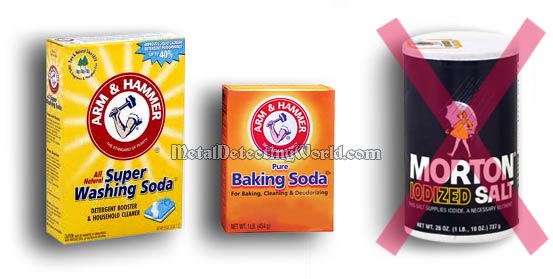How To Clean Coins and Jewelry with Electrolysis - A Detailed Tutorial, page 13
3. Prepare Electrolytic Cell and Coins for Electrolysis
1) How To Make Electrolyte
Making an electrolyte for the electrolytic cleaning of coins is easy: dissolve one tablespoon of Baking soda (sodium bicarbonate) in one gallon (3.78 liters) of distilled water. Some conservators claim that washing soda is more useful for electrolytic cleaning than baking soda because the washing soda is routinely used to remove grease, oil, and certain minerals.
From my experience with electrolysis, I found out that the baking soda electrolyte is as effective as the washing soda solution, and harmless - it does not irritate the skin like the washing soda. And the minor contaminants - oil, grease and minerals, can be easily washed off the coins with acetone.
Washing and Baking Soda

You can either buy the washing soda at any supermarket or make your own sodium carbonate at home. Spread baking soda out onto a cookie sheet and bake it in the oven at 300°F (149°C) for an hour. The heat will drive away carbon dioxide (CO2) and water molecules; thus, making washing soda.
 DO NOT use TABLE SALT (Sodium Chloride) in your electrolytic solution! The electrolytic solution made with the table salt will generate CHLORINE GAS that can injure you, and quickly! Another hazard may occur if the chlorine from salt is combined with evolving hydrogen making Hydrochloric Acid!
DO NOT use TABLE SALT (Sodium Chloride) in your electrolytic solution! The electrolytic solution made with the table salt will generate CHLORINE GAS that can injure you, and quickly! Another hazard may occur if the chlorine from salt is combined with evolving hydrogen making Hydrochloric Acid!
Also, it is NOT recommended to add lye and/or drain cleaners (full of contaminants) to the electrolyte! It has been proven that no appreciable increase of the process speed is achieved by using lye or any other harmful "addition". It is really not worth of taking the risks associated with usage of the hazardous material and disposal of caustic solution.
• What Water Is Used in Electrolyte
It is generally recommended that only distilled water (available at most supermarkets) or de-ionized water should be used for making the electrolyte. The tap water may contain certain minerals or chemicals that could contaminate the electrolyte, be deposited on coins, or interfere with the process.
• How To Determine a Right Amount Of Baking Soda for Electrolyte
If you use a battery charger with an ammeter as the power supply for electrolysis, there is a simple way to determine an optimal amount of baking soda required for making the electrolyte in a vat of any volume; no calculations and measurements are required.
After you place an electrode and the coin into the jar and connect everything (all details are given on the following pages), fill the container with water (electrode connectors - alligator clips, should not be immersed!), set the amperage controlling knob in an appropriate position, turn on the battery charger, and slowly add a small amount of baking (or washing) soda into the jar while stirring well, so all soda is quickly dissolved.
Now watch the ammeter indicator hand (or pointer) while adding more soda: the pointer will move slow at first, but then will go faster, as the soda's concentration in solution is increasing. When the pointer stops (amperage stops rising rapidly), the amount of soda in the solution is optimal, i.e. not too much current passes through the electrolyte to get the job done, so the power supply - your battery charger, will not be "overloaded", and any connecting wires will not get too hot and burnt. Your electrolyte is ready! And your electrolysis machine will clean the coins with maximum efficiency!
You should make up an ample supply of electrolyte not for adding it to the electrolytic cell during electrolysis but to replace the dirty and expended electrolytic solution. When the electrolyte layer has lowered during the process, you need to add only WATER to it!
2) Prepare Coins for Electrolysis: Mechanical Removal of Loose Dirt and Crust with Nylon Brush
Prior to electrolytic coin cleaning, any coin should be "prepared" for the process, so the process could be easily started and run without difficulties and in a cleaner environment inside the electrolytic cell.
In case of a freshly dug coin, it is recommended to place it into a hot water bath for a while, so the dirt, debris and excessive crust will loosen a little. The coin should undergo this treatment a few times, and each soaking is followed by brushing the coin with a nylon brush until most of the dirt and loose encrustation comes off. Try to get as much of the crud off the coin manually before electrolyzing the coin.